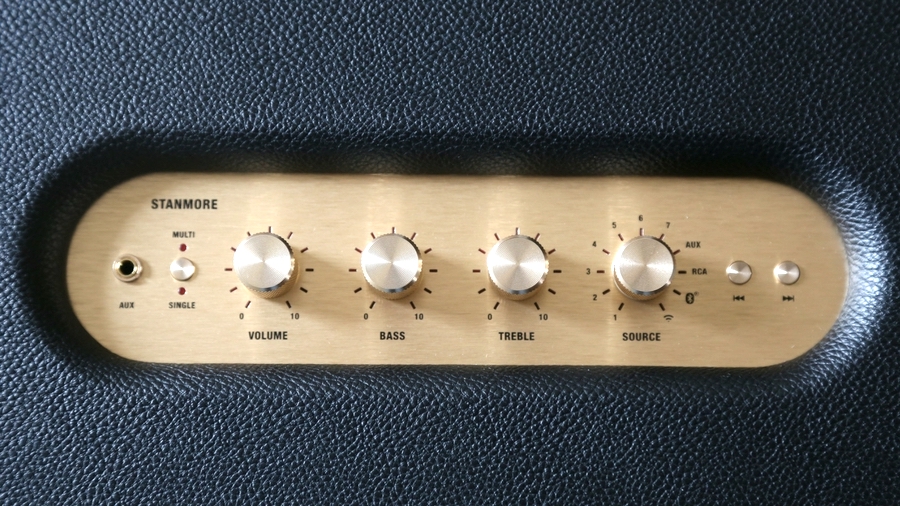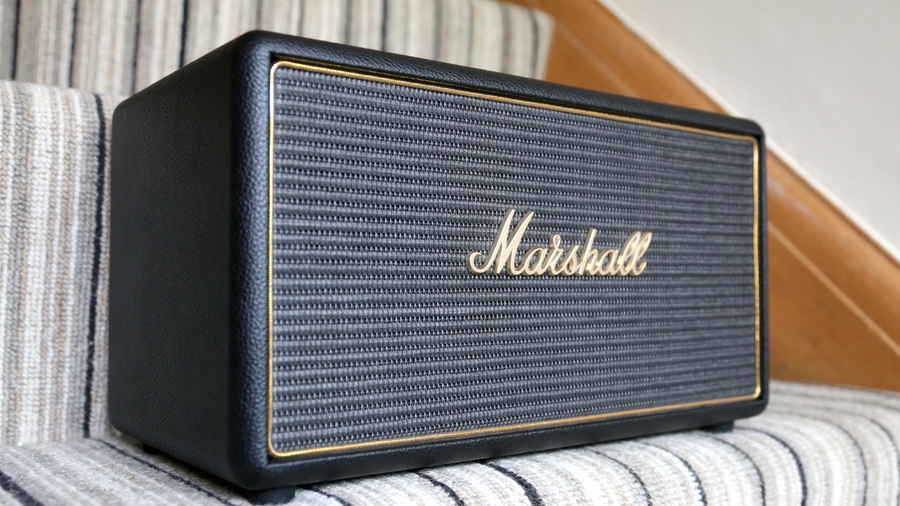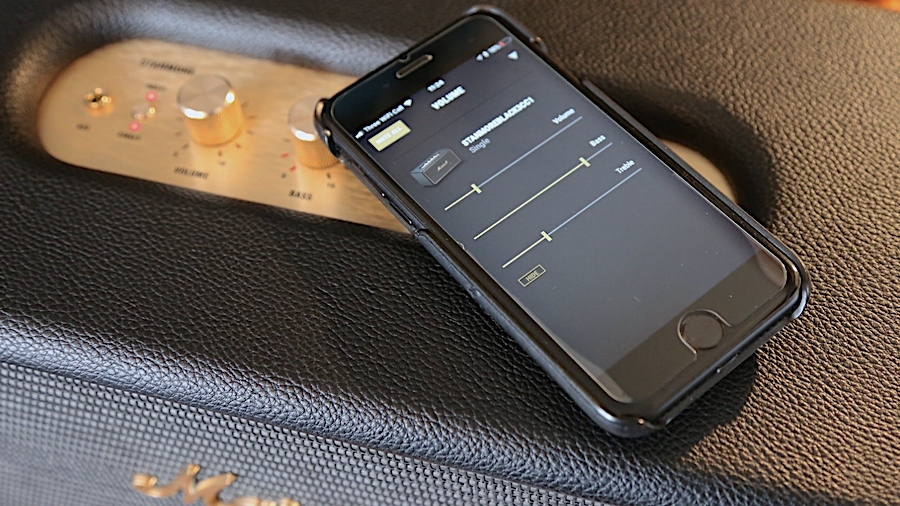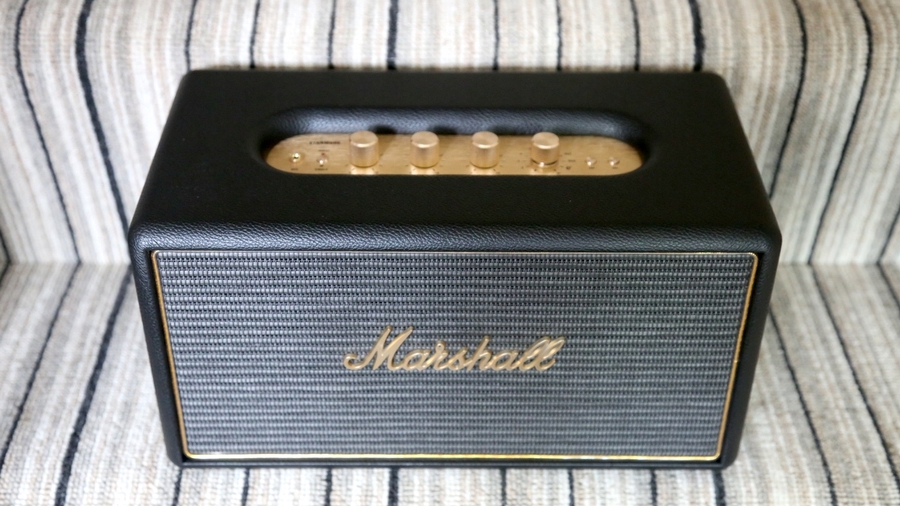TechRadar Verdict
Do you need wireless music this loud? Probably not, but this easy to use and iconically designed speaker copes well with lossless tunes via AirPlay, ChromeCast and Spotify Connect.
Pros
- +
AirPlay, ChromeCast, Bluetooth & Spotify Connect
- +
Attractive black vinyl design with brass buttons
- +
Punchy, bassy … and loud!
Cons
- -
Big, heavy build
- -
No remote control
- -
High price
Why you can trust TechRadar
Editor's note: Now that we've had a chance to try the Stanmore out in parallel with both the Acton and Woburn we've been able to establish its abilities as a purely multi-room speaker. With all its functionality tested, we've now upgraded the review from a hands on preview to a full review complete with a score.
Review continues below...
Have you ever been to a gig that doesn't have a Marshall speaker somewhere on the stage? Renowned for its guitar amps it may be, but the Marshall brand is here used to sell multi-room music under the auspices of Zound Industries.
And the result is a classic rock sound. Wireless speakers may be all the rage, but Zound recently upgraded all of its Marshall speakers by adding Wi-Fi, instantly bringing into play must-have lossless streaming features like AirPlay, ChromeCast and Spotify Connect. However, Bluetooth remains on all Marshall speakers, too.
Not that you'll be taking the upgraded Stanmore speaker anywhere but into your living room or kitchen for a permanent stay. The middle-sized of Marshall's three refreshed multi-room speakers, the Stanmore boasts a chunky, amp-like design, as does the even bigger Woburn speaker, with only the smaller Acton designed for mobility.
Crucially, none of them come with a remote control, instead relying solely on the free Marshall Multi-Room app. There are people who would never pay $450 (£399 / AU$573) for a music system without a dedicated remote control, but it's completely understandable given that the Stanmore's standout features all rely on its phone-based capabilities.

Design
At 350x185x185mm and 4.7kg, the Stanmore is a beast. It may be small for a guitar amp, but as far as Bluetooth and multi-room speakers go it's incredibly large. The Stanmore is all about the big sound, and we get that. This is a Marshall product, after all.
Sign up for breaking news, reviews, opinion, top tech deals, and more.
Made from wood, and covered in black vinyl just like an amp, the Stanmore has familiar rounded corners, a flexible speaker grille with gold edging, and intensely retro brass knobs on the top. It may lack a remote control, but the Stanmore's volume, bass, treble and source knobs are a stylistic stand-out.

Nearby are two tiny track-skip buttons and a 3.5 mm aux. input for attaching a phone, laptop or a turntable. There's also a button for toggling between its multi-room and single source modes. On the back, there's a right and left-channel RCA audio inputs, intended for a turntable. So despite its plethora of connections – more than a Sonos Play:5, for sure – the Stanmore cuts a streamlined, if retro look.
Features
Design-wise it might be from the 1970s, but on the inside the Stanmore is all about connectivity, with WiFi the big addition alongside the existing Bluetooth 4.2 connectivity.
Chromecast, Spotify Connect and AirPlay compatible, the Stanmore has Internet radio, too; all of that is configured via the Marshall Multi-Room app. Inside the Stanmore are a 50W class D amplifier for the woofer and two 15W class D amplifiers for the tweeters. That's 80W in total; we're expecting some big noise.

Set-up
If you want get the Stanmore up and running immediately, it's to Bluetooth you should head. A quick flick to Bluetooth mode on the top dial, easy pairing, and you're away. As it successfully pairs, an audible guitar riff plays through the Stanmore's speaker. It's a bit naff, but it's short.
Connecting via AirPlay took a little longer, but eventually we linked it to WiFi over a 2.4 GHz connection. Once that was done it was all about the app. You can choose which mode you put it into via the app, but critical for proper personalisation are the seven presets where you can store shortcuts to specific Internet radio stations, podcasts, or Spotify playlists.
That does make it a lot easier to navigate and use quickly, particularly since you can toggle between them on the source dial on top of the Stanmore as well as via the app. There's also a simple equaliser section within the app where you can change the volume, bass and treble levels of the Stanmore.

Performance
For all its iconic design riffs, the Stanmore is all about sound quality. The advantage of using WiFi is, of course, lossless sound quality, and it's here that the Stanmore really excels.
While Bluetooth music lacks depth and width, tunes streamed to the Stanmore first via AirPlay and then via Spotify from an iPhone were exceptionally full, with vocals detailed and bass-lines given a tremendous lift.
We especially liked the way the bass and treble knobs bring only a slight tweak to the overall sound, showing the maker's well-placed confidence in its overall balance. Left about half-way they lend the sound field a lot of accuracy no matter what you're listening to.
Ditto for volume, which goes extremely loud. Far too loud, in fact, for any room in your house - though there's zero distortion. A tiny criticism is that AirPlay tracks take a second or two to start on the Stanmore, and we also noticed the occasional double-start (but that could have been our WiFi network).
However, the speaker works well as part of a multi-room setup. We got the Stanmore playing alongside both its siblings (the Acton and Woburn) and our chosen track played perfectly in sync across the three speakers.

Verdict
What we most like about the Stanmore is its sound quality. Okay, so it comes at the cost of having to house a rather big, bulky speaker on your bookshelf, but that's a small price to pay for some well-rounded, detailed, but most of all, bassy and loud tunes we've ever streamed from phone. We also loved the styling, especially the brass knobs, which make it easy to control when your phone is otherwise disposed – or it's being controlled by someone else's phone.
That said, its lack of remote control is going to bother some people, especially those that use the Stanmore as a single speaker, with a turntable attached. And while we're not saying that the Marshall isn't worth that high price – it sounds great and the build quality is excellent – does anyone really want to pay that much for a Wi-fi Hi-Fi?

Here's a great example of a wireless multi-room speaker that is excellent, but over-specified for most users. We love the fact that you can daisy-chain it to other products from Marshall, and the sound quality is consistently excellent. The recognisable and thoroughly iconic design is great, too, and will especially suit anyone with a musical heritage. Set-up was reasonably easy and the lossless sound quality impressive. The lack of a remote control may bother some, but the brass buttons on the device itself are very pleasing to the eye, as well as being functional. We loved 'em.
However, the 80W Stanmore is expensive – not over-priced, but over-specified – because it will almost certainly be too powerful a speaker for your living room or kitchen. If you want power and a unique look, though, the Stanmore is really hard to match for multi-room.
- These are the best connected speakers around right now.

Jamie is a freelance tech, travel and space journalist based in the UK. He’s been writing regularly for Techradar since it was launched in 2008 and also writes regularly for Forbes, The Telegraph, the South China Morning Post, Sky & Telescope and the Sky At Night magazine as well as other Future titles T3, Digital Camera World, All About Space and Space.com. He also edits two of his own websites, TravGear.com and WhenIsTheNextEclipse.com that reflect his obsession with travel gear and solar eclipse travel. He is the author of A Stargazing Program For Beginners (Springer, 2015),
